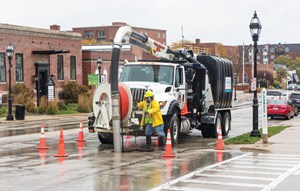March 2021 Vol. 76 No. 3
Rehab Technology
Spring Cleaning, Sewer Style
By John Manijak, Michels Corporation
Spring cleaning is not just reserved for that pile of old magazines and unfinished winter projects that built up in your garage. It is an essential tool in the sewer maintenance toolbelt that every public works manager should have ready once those snowmen start shrinking.
Right about this time every year, we often find ourselves thinking about those warm spring days. The sun peeking out behind the rain clouds and the green grass replacing the mounds of snow are just two visions that come to mind.
Yes, spring is just around the corner. With it comes beautiful days for working outside, but it also means extra water that, when added to a sewer system, may be cause for concern.
Snow melt and spring showers will test storm system capacity. If catch basins and inlets are still loaded with leaves from last fall, they cannot function properly to filter out the debris from the street to keep it from entering storm mainlines. As the dirt fills up storm mains, water retainage is left to the open roads, ditches and culvert pipes. Early spring is the best time to clean and inspect those basins, inlets and mainlines – before the April showers bring May flowers.
Whether using halite (sodium chloride) or sand as a preventive measure during snowfalls, both treatments can be detrimental to storm systems. After melting the snow, road salts combine with the water that is drained away through storm pipes. Most systems are comprised of concrete or corrugated metal pipes, which are subject to degradation from the chemical.
A good spring cleaning will help by washing down the structures and pipes. Although less evasive against concretes, sand will continue to collect in the inlets and basins, reducing overall collection system capacity.
Storm sewers aren’t the only ones affected by winter melt and spring showers. As the water saturates the ground and enters the sanitary and storm trenches, it flows freely to sewers at open joints and lateral connections. The excess inflow and infiltration (I&I) rreduces overall capacity, resulting in sanitary sewer overflows, flooded basements and emergency calls.
The additional water also adds to the overall treatment costs at the plants, while at the same time, removing the substrates that provide pipe support. This causes voids and sinkholes, and adds to the debris within the pipe.
Throughout this brutal winter, we have seen several freeze/thaw cycles that often play havoc with manholes. As the ground freezes, the water expands and lifts the rings and frames. After a warmer day, the top layers quickly thaw, relaxing the structure. This constant movement causes cracks and fractures that weaken areas of the manhole, allowing for inflow at the chimney areas.
These areas are also subject to abuse from snowplows overhead as their blades scrape the snow and ice from the road. A perfect solution to stopping water from entering at these points is installing a protective chimney boot that can stretch with the movement, as well as provide protection against the sodium chloride that enters with the melted snow.
A holistic approach to sewer rehabilitation provides the services needed to identify sewer problems during spring cleaning and the ability to repair them when found. Here are five ways to get sewer systems ready to celebrate spring and the rest of the year.
- Cleaning of basins, inlets, culverts, and mainlines
- CCTV inspection
- Lateral inspection
- Manhole inspection and grading
- Joint testing and sealing
Once your sewer system has been cleaned, it is not unusual to identify specific issues that require various rehabilitation services, such as cured-in-place pipe (CIPP) lining, municipal grouting, short liner installation, manhole rehabilitation and geopolymer culvert lining.
Remember, before the road resurfacing programs begin, make sure that the sewers below are in good shape by spring-cleaning and televising them. Use this time to practice good preventive maintenance measures and prepare for the construction season ahead. Seasonal maintenance helps to provide key information that will keep systems operating properly.
FOR MORE INFORMATION:
Michels Corporation, (920) 924-4300, www.michels.us





Comments